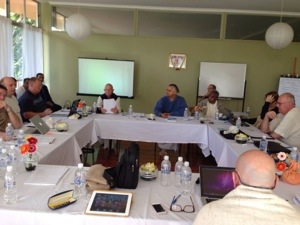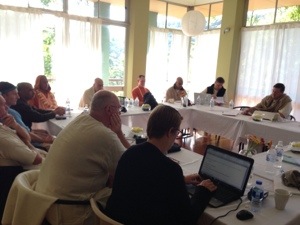
His habit is to identify his self with the matrix into which his person is poured, and to identify his self-interest with the experiences he finds in that matrix.
A person is an eternal being with limited freedom of choice. His awareness of what choices lie before him is shaped by time-bound material phenomena, which include experiences that are physical, emotional, and mental. The phenomena a person currently experiences are in reaction to his past actions. These reactions are plotted in accordance with three modes of work. Due to his past work within these modes, a person presently has good, mediocre, and bad physical, emotional, and mental experiences. All such experiences are temporary.
In the midst of the matrix of my experience, what do I, a person, ultimately seek? The answer is freedom. “What light is to the eyes,” said a wise man, “what air is to the lungs, what love is to the heart, liberty is to the soul of man.” Everyone wants liberation. Srila Prabhupada, my spiritual teacher, explains that this is the constitutional position of the soul. Constitutionally, we are eternal, complete in knowledge, and full of happiness. But the experience of matter suppresses the experience of our original nature. Now we find ourselves subject to time, ignorance, and misery. Innately, we all yearn for freedom from that suppression.
Three false conceptions of freedom
A liberated person is free to make real choices. Real choice is possible where there are options of real satisfaction. Unfortunately, the matrix of our experience may not permit us free choice. Why? The answer is quite simple: We are eternal, yet the options available to us in this world are not. We want the experience of unadulterated bliss, yet the options available to us in this world are mixed with distress. Choice as we know it now, within the matrix of our present experience, is insubstantial. We select shadows – of love, social life, recreation and so on – that appear and disappear in time. Yet within the confines of our experience, it seems very difficult for us to understand that we have no real freedom of choice. The matrix even supplies us with three notions of freedom: in goodness, in passion, and in ignorance. Unfortunately, they are not real.
“Freedom” in the mode of goodness
Though it too is ultimately false, the goodness conception of freedom is superior to the others. Here, a person aspires for freedom by knowledge and morality, virtues that greatly boost the power of detachment. However, knowledge and morality do not grant us authority over our senses, namely the eyes, the tongue, the nose, the ear, and the sense of touch. Even in goodness, consciousness remains subjected to physical, emotional, and mental phenomena arising uncontrollably out of good, bad, and mixed fortune. A learned, moral person experiences those phenomena in an analytical, self-composed manner. Being detached from his experience, he may think himself liberated. But he is not really liberated if, in the name of goodness, he remains habituated to a life of imprisonment within mundane sensation. In his book The King of Knowledge, chapter seven, Srila Prabhupada explains:
“Goodness is also a kind of contamination. In goodness one becomes aware of his position and transcendental subjects, etc., but his defect is in thinking, ’Now I have understood everything. Now I am all right.’ He wants to stay here. In other words, the person in the mode of goodness becomes a first class prisoner and, becoming happy in the prison house, wants to stay there.”
Our two natures
Our first nature, the substance of our person, is eternal spirit. Our second nature is habit. For example, we have the habit to rejoice or lament our change of fortune. In the language of the Bhagavad-gita, this habit is the duality of bewilderment, which captivates all creatures born in the material world. In a lecture, Srila Prabhupada gave the illustration of a man crying over the death of a son. Who in the world will not cry if his son dies? Even a man of learning and morality will cry at such a loss. “It is habitual,” Srila Prabhupada said. But a person in the mode of goodness tries to be philosophical about it.
In the ancient world, philosophy meant primarily the intellectual method of distinguishing the spirit self from the habits of the body and the mind. Philosophers of the classical Mediterranean culture, which sired European civilization, knew that our first nature can be made well or unwell. The first nature (the spirt self) is made well by the cultivation of virtue. Conversely, as one loses his virtue, his first nature sickens.
In the Latin language, like Sanskrit, the root vir means “strong;” hence, virtue is the quality of a strong, healthy spirit. In European culture there are four classical virtues, foremost of which is sophia, true knowledge of the self beyond time. The others are fortitude, justice, and temperance or self-restraint. In Vedic culture too there are four similar virtues: truthfulness, austerity, mercy, and cleanliness. These are fostered when we refrain from gambling, intoxication, meat-eating (or lack of compassion towards animals and other creatures), and licentiousness.
Attachment to truth is essential to detachment from matter. Above all, truth means the timeless truth beyond my temporal self-image. The image of myself as a father of a son is “true” in a biological, psychological, and social sense, but in fact it is not true in the highest sense because my role as a father is only temporary. It takes real virtue to admit this.
As he laments the death of a son, the grief of a virtuous father is tempered by a sober insight into the deeper meaning of his change of fortune. He knows that what is given and taken away is not his own, for the eternal soul can possess nothing that is temporary. Hence, misfortune for a good person is not really bad. It often serves a lesson healthier than good fortune can, since in so-called good times we tend to forget that nothing in this world can last. As Philosophia, goddess of Greek and Roman thought, declares in The Consolation of Philosophy by Boethius: “But if you could see the plan of providence, you would not think there was evil anywhere.”
The world is so planned that misfortune follows good fortune. The childless King Citraketu felt himself greatly blessed by providence when at last his wife bore him a son. Shortly, in a palace intrigue, the baby was poisoned. The king was emotionally crushed. But the sage Narada showed Citraketu that this loss was the very same gain he had celebrated days before. Thus the son was “good” and “evil,” “friend” and “enemy,” the object of both the king’s happiness and distress. When he understood this, the king really gained something – detachment.
For one detached from material gain and loss, “being” is far more important than “becoming” (becoming a father, for instance). No matter what good or ill fortune comes with time, the virtuous person chooses timeless being – his spiritual substance – over any material situation. On the other hand, a person of weak virtue is attached to the ebb and flow of his destiny. He sees the appearance and disappearance of pleasant and unpleasant experiences within time as good or evil. Because he is blind to his own karma under the wheel of fate, he supposes fate to be blind chance; or he supposes there is no fate at all, that success is tenacity of purpose, and failure the reward for laziness. In any case, his habit is to identify his self with the matrix into which his person is poured, and to identify his self-interest with the experiences he finds in that matrix. Thus, he who is pure spirit, becomes dependent upon the shifting arrangements of matter. Such is his bad habit.
When one becomes increasingly dependent upon and controlled by a bad habit, he is said to be addicted. That addiction is sin. Sin is persistent ignorance of our first nature. Sin develops from meat-eating (or participation in unnecessary animal slaughter), licentiousness, gambling, and intoxication, four kinds of behavior that corrode virtue.
“Freedom” in the mode of passion
In the world of time, the mind hunts for sensual delights that are in turn haunted by old age, disease, death, and rebirth. Yet it is our habit to cherish the restless mind and senses as the agents of our hope. From this habit a passionate philosophy of freedom develops, one that some thinkers call “instrumentalism.”
An instrumentalist is a person for whom the “instrument panel” of the mind and senses is the only valid source of knowledge. He believes the human being can find, with the help of these instruments, the answer to the complex problems of material existence. A human is distinguished from other creatures not by his virtues but by the complexity of his problems. Human questions of right and wrong, true and false, can be solved only on the basis of useful facts, for usefulness is a measure of truth. Theories of the soul and its virtues are useless in practical affairs. Therefore they are untrue. Theories are to be judged not by their “goodness” but by their consequences: what results they give us.
The passionate instrumentalist uses his mind and senses like tools, to locate and dig up treasures buried deep within material nature – riches, rare pleasures, sources of energy, cosmic secrets – that he hopes will serve the needs of the human race. His outlook is prospective, since his faith is invested in the future. Thus “becoming” is far more important than “being.”
But what will he become? He will certainly not become free. His future holds countless births and deaths, for the philosophy of instrumentalism is simply the philosophy of embodied existence. For example, aerospace technology has made it possible for humans to fly high in the sky. If in the human body I convince myself that the most important problems of life are those that flight can solve, I deserve no better than to become a bird in my next life.
“Freedom” in the mode of ignorance
The person in the mode of goodness seeks freedom in being rather than becoming. The person in the mode of passion seeks freedom in becoming rather than being. The person in the mode of ignorance seeks freedom in non-being, or nihilism. He is retrospective in his outlook because in his heart he nurses unending dismay, anger, and frustration about his past experience. Thus he sees hope neither in the present nor future. He chooses to cancel out further involvement in this world by negating his personal self. There are demanding, highly disciplined philosophical systems dedicated to losing one’s self; but, in today’s Western world, many people try it the easy way, through alcohol, drugs, and suicide. Now, there are other angry, frustrated individuals who are not content to passively extinguish themselves. They want to drag the world down with them. Through aggressive, violent behavior and the oppressive domination of others, they seek freedom from the trouble of having to think rationally about the purpose of life. Striking out at the world in blind hatred and trampling it underfoot is just a motif of self-annihilation, as is clear from the examples of history’s famous tyrants like Caligula and Adolf Hitler. Thus, whether he takes the passive or aggressive path, the nihilist’s goal is to eradicate all differences in his life, which means to eradicate life itself.
A creed of voidism is, ex nihilo omne ens qua ens fit – “Every being in so far as it is being is made out of nothing.” If my being is nothing, then neither my self who chooses nor the world of choices has real importance. For a person in goodness, it is important to always choose internal well-being over entanglement in external variety. For a person in passion, it is important to entangle oneself in external variety; yes, more important even than internal well-being. But for a person in ignorance, all this is not worth the trouble.
Good people struggle to be free from the loss of the self to material attraction. Passionate people have no problem with losing themselves in that way. But they struggle to get free from the problems that result from their attraction to matter. The ignorant person claims freedom by disclaiming the importance of the struggles of goodness and passion. He thinks eternal life and worldly happiness are impossible, and the effort to attain them is a waste, an absurdity, nothingness. In Caligula, the French philosopher Albert Camus wrote, “Really this world of ours, this scheme of things as they call it, is quite intolerable. That’s why I want the moon, or happiness, or eternal life – something, in fact, that may sound crazy, but which isn’t this world…This world has no importance; once a man realizes that, he wins his freedom. And yet, I know that all I need is for the impossible to be the impossible!”
On one side, Camus advocated the “ignorant” freedom gained by rejecting life in this world. But that freedom is negative. It is like getting rid of a persistent headache by chopping off the head. On the other side, he admitted this is not what we positively want and need. We want and need positive freedom “to do the impossible.” And what is this impossibility, “Which isn’t this world,” which isn’t the matrix of our present experience? As explained before, it is the freedom to choose among options of real satisfaction, options formed out of the nature of eternal existence, complete knowledge, and pure bliss. But to one in ignorance, because it seems impossible, it is crazy.
Real Freedom
Srimad-Bhagavatam, 3.25.15, explains how a person can be bound by and liberated from the three modes of nature:
“The stage in which the consciousness of the living entity is attracted by the three modes of material nature is called conditional life. But when that same consciousness is attached to the Supreme Personality of Godhead, one is situated in the consciousness of liberation.”
Choice, the essential function of an individual’s consciousness, is defined here. We have two options: to choose to associate with the three modes of nature, or to choose the divine association.
If we choose the modes of nature, we are entrapped by them (the word ‘guna’ means “rope;” each of the modes is a strand of a rope that binds the soul within the matrix of temporal experience). Once so trapped, the soul’s dynamic essence, his power of choice, alternates rapidly back and forth between material dualities: mind and matter, intelligence and foolishness, good and evil, light and darkness, male and female, young and old, sickness and health, heat and cold, pleasure and pain, happiness and distress, wealth and poverty, beauty and ugliness, excitement and boredom, sobriety and whimsy, sanity and insanity, honor and dishonor, fame and infamy, birth and death, up and down.
As long as the soul continues to choose between duality, his field of material activities is perpetuated life after life. Choosing the divine association unties the knot of bondage to material duality. As we shall see, liberation in spiritual association affords the soul unlimited opportunities for substantial choice.
(Excerpt from the book Transcendental Personalism by Suhotra Swami)
























